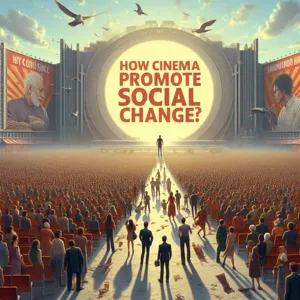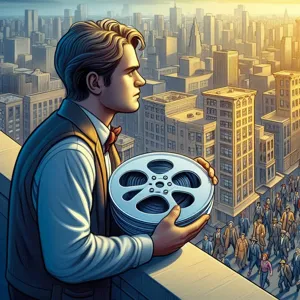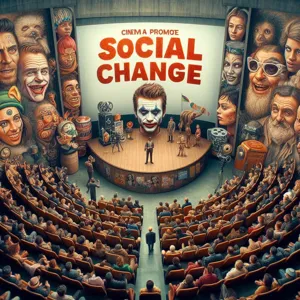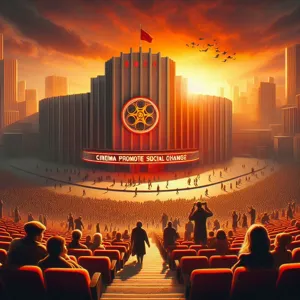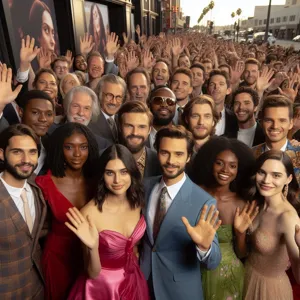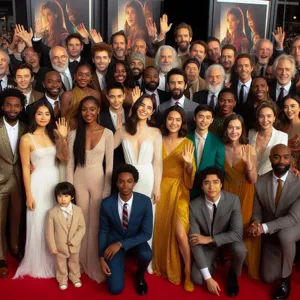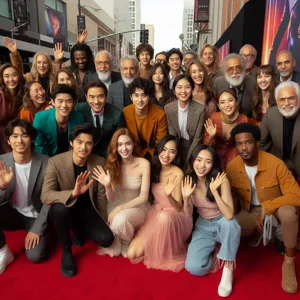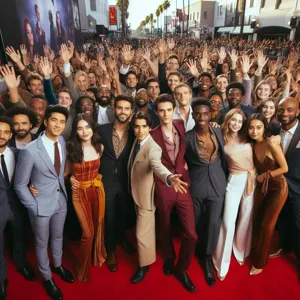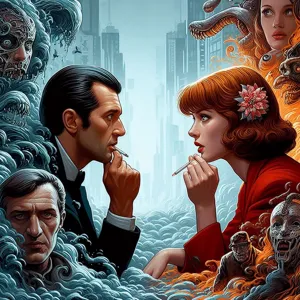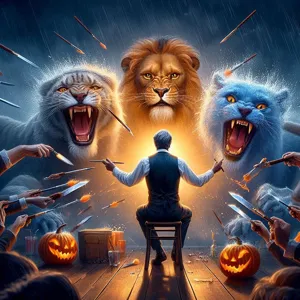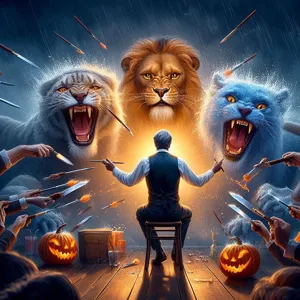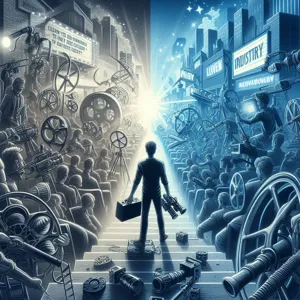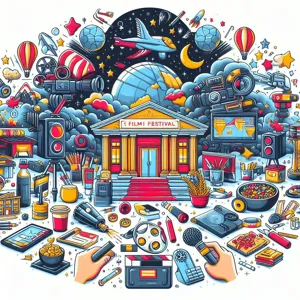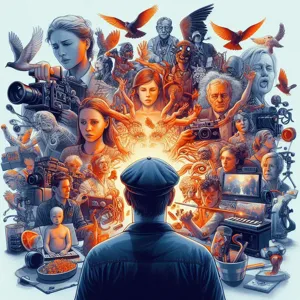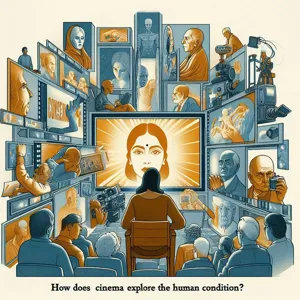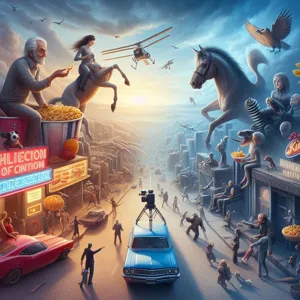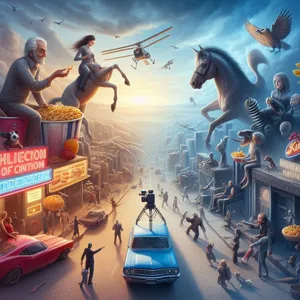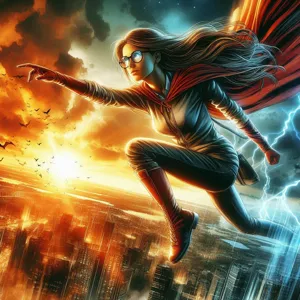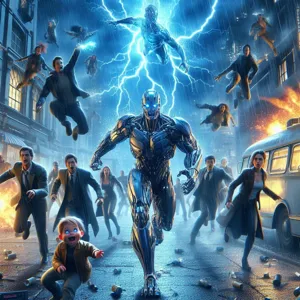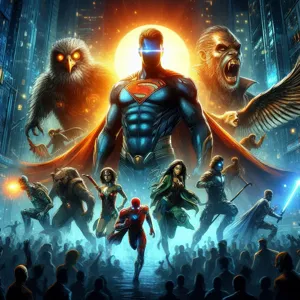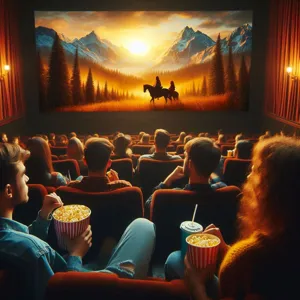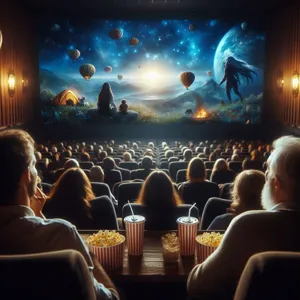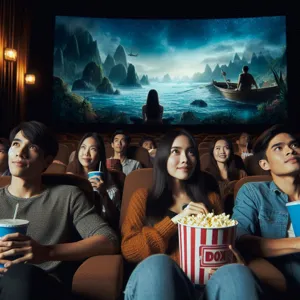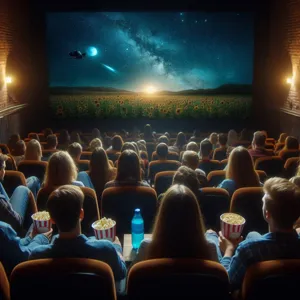In the world of cinema, a single scene can reverberate through the hearts and minds of audiences, leaving an indelible mark that transcends the confines of the screen.
These captivating moments serve as powerful storytelling devices, encapsulating the essence of a character’s journey or a pivotal plot twist in mere seconds. Whether it’s the quiet intensity of a lingering gaze, the explosive climax of an unexpected confrontation, or the serene beauty of a breathtaking landscape, these scenes have the extraordinary ability to evoke emotions and provoke thought, often becoming iconic in their own right. In this blog post, we will delve into the art of film storytelling and explore how a meticulously crafted scene can elevate a narrative, enhance character development, and create lasting connections with viewers. Join us as we analyze some of the most memorable moments in film history, uncovering the magic that makes them resonate across generations.
1. Introduction to the Power of a Single Scene

In the realm of filmmaking, the adage “less is more” often rings true, particularly when it comes to the profound impact of a single scene. A carefully crafted moment can encapsulate the essence of a story, evoke a whirlwind of emotions, and leave an indelible mark on the audience’s memory. From the breathtaking reveal of a character’s inner turmoil to the quiet, poignant exchanges that speak volumes without uttering a word, a single scene can shift the trajectory of a narrative and redefine how a viewer perceives the entire film.
Consider the heart-wrenching scene in “The Shawshank Redemption” where Andy Dufresne plays opera music over the prison’s loudspeakers. In just a few fleeting minutes, the audience is transported from the drudgery of prison life to the soaring beauty of freedom and hope. This moment not only reveals Andy’s defiance against his oppressive surroundings but also offers a rare glimpse of humanity to his fellow inmates. It’s a powerful reminder that even in the darkest of places, beauty and resilience can thrive.
Scenes like this demonstrate that a single moment, when executed with intention and artistry, can resonate far beyond the confines of the screen. It can inspire, provoke thought, and even ignite change. As we delve deeper into the analysis of iconic scenes throughout cinematic history, we will explore how filmmakers harness the power of a single moment to create unforgettable storytelling experiences that linger long after the credits roll.
2. Defining “Captivating Moments” in Film
Captivating moments in film are those powerful scenes that resonate deeply with audiences, etching themselves into memory long after the credits roll. These moments often transcend mere entertainment; they evoke profound emotions, provoke thought, and sometimes even inspire action. They can be as subtle as a fleeting glance exchanged between characters or as grand as a climactic battle scene, yet what unites them is their ability to connect with viewers on a visceral level.
At their core, captivating moments are defined by a perfect synergy of storytelling elements. This includes strong character development, evocative cinematography, and a compelling narrative arc. For instance, think of the moment in “The Shawshank Redemption” when Andy Dufresne escapes from prison. The culmination of years of struggle, hope, and resilience is captured in a single, breathtaking shot that leaves viewers breathless. The emotion is palpable, and the audience cannot help but feel a sense of triumph alongside him.
Moreover, captivating moments often hinge on timing and pacing. A well-placed pause, a sudden shift in music, or an unexpected twist can elevate a scene from ordinary to unforgettable. The emotional weight of a moment can be amplified when it arrives at just the right point in the story, often serving as a turning point or a revelation that shifts the audience’s understanding of the characters or plot.
These moments also serve as touchstones for the audience, providing a shared experience that can spark conversations and interpretations long after the film has ended. They are the scenes we revisit, quote, and analyze, revealing layers of meaning that resonate with our individual experiences and emotions. In essence, captivating moments in film act as the heartbeat of the narrative, crafting an emotional bond that lingers in the minds and hearts of viewers, making them an essential component of effective storytelling.
3. The Role of Visual Storytelling in Cinema

Visual storytelling is the heartbeat of cinema, transforming mere words on a script into a rich tapestry of emotions, themes, and experiences. In film, visuals transcend the limitations of spoken dialogue, allowing filmmakers to communicate complex narratives and deep emotional undertones through imagery alone. Each frame is meticulously crafted, where lighting, color palettes, and camera angles work harmoniously to evoke feelings and set the tone of a scene.
Consider the iconic opening sequence of *The Lion King*, where the golden savanna stretches out before the audience, bathed in warm sunlight as the circle of life unfolds. This powerful visual not only introduces the audience to the lush African landscape but also establishes the themes of growth, connection, and the eternal cycle of life. It’s a vivid moment that resonates on a deeper level, illustrating how visual storytelling can encapsulate emotions that words alone might fail to convey.
Moreover, cinematography plays a crucial role in shaping the audience’s perception and emotional response. A close-up shot of a character’s face can reveal their inner turmoil, while a wide shot can emphasize isolation or connection within a scene. For instance, the use of shadows and light in a thriller can create suspense, while vibrant hues in a romantic film can embody love and joy. Through careful manipulation of these visual elements, filmmakers guide viewers along their intended emotional journey.
In essence, visual storytelling enriches the cinematic experience, allowing audiences to engage with the narrative more profoundly. It is through these captivating visuals that filmmakers craft moments that linger in our minds long after the credits roll, inviting us to reflect on the deeper meanings and emotions behind the story. As we explore the impact of a single scene in film storytelling, we come to appreciate the profound influence that visuals wield in creating unforgettable moments that resonate with viewers on a universal level.
4. Analyzing Iconic Scenes: Case Studies
When it comes to film storytelling, iconic scenes often serve as the heartbeat of a cinematic experience, encapsulating emotions, themes, and character arcs in a powerful, concise burst. In this section, we will delve into several case studies that highlight how a single scene can elevate a film from mere entertainment to a profound commentary on the human experience.
Take, for instance, the hauntingly beautiful scene in *The Shawshank Redemption* where Andy Dufresne plays Mozart’s “The Marriage of Figaro” over the prison intercom. In just a few minutes, this moment transcends the grim reality of Shawshank Penitentiary and transports the inmates—and the audience—into a realm of hope and beauty. The contrast between the uplifting music and the stark prison environment poignantly illustrates the power of art to uplift the human spirit, making it a seminal moment that resonates long after the credits roll.
Another compelling example is the iconic “I coulda been a contender” scene from *On the Waterfront*, where Terry Malloy confronts his brother Charley. The raw vulnerability displayed in Marlon Brando’s performance encapsulates the struggle of lost potential and familial loyalty. This single moment not only crystallizes Terry’s internal conflict but also serves as a microcosm of the broader themes of regret and redemption that permeate the film. It’s a scene that lingers in the mind, prompting reflection on the choices we make and their lasting impact on our lives.
In *Pulp Fiction*, the diner scene with Jules and Ringo provides a masterclass in dialogue-driven tension. As Jules delivers his iconic “Ezekiel 25:17” monologue, we witness a transformation that encapsulates the film’s exploration of morality and redemption. The scene’s clever interplay of humor and threat creates an unforgettable climax that leaves viewers pondering the nature of fate and free will.
Through these analyses, we uncover how a single scene can encapsulate complex themes, evoke strong emotions, and create lasting memories for the audience. Each of these moments serves as a testament to the power of cinematic storytelling, reminding us that sometimes, it’s not the entire film that lingers in our thoughts, but rather those captivating moments that resonate deeply within us.
5. Emotional Resonance: How a Scene Can Move Audiences

Emotional resonance is a powerful force in film storytelling, capable of transcending the screen and etching unforgettable moments in the hearts of audiences. A single scene can encapsulate the essence of human experience—joy, sorrow, love, and loss—allowing viewers to connect deeply with the characters on a profound level. This connection often hinges on the meticulous artistry of filmmaking, where every element, from dialogue to cinematography, works harmoniously to evoke a specific emotion.
Consider, for instance, the iconic scene in “The Lion King,” where Simba stands on Pride Rock, gazing into the horizon as he confronts his past. The combination of haunting music, stunning visuals, and the poignant journey of self-discovery creates a moment that resonates with audiences of all ages. It’s not just the narrative that moves us; it’s the raw vulnerability portrayed by the characters that taps into our own experiences of growth and acceptance.
Filmmakers often employ various techniques to amplify emotional resonance. Close-up shots capture subtle facial expressions, allowing viewers to witness the turmoil or elation in a character’s eyes. A well-timed pause in dialogue can heighten tension or intimacy, making the audience hold their breath in anticipation. The use of sound—whether it’s a heart-wrenching score or the silence that follows a shocking revelation—can also dictate the emotional landscape of a scene.
This emotional connection can lead to a lasting impact, prompting audiences to reflect on their own lives and relationships long after the credits roll. A scene that stirs feelings of nostalgia or empathy can inspire conversations, influence our perspectives on life, and even drive social change. In an era where we are bombarded with content, it is those emotionally charged moments that linger in our minds, reminding us of the power of storytelling and the shared human experience.
In essence, when a film successfully creates a scene that resonates emotionally, it does more than entertain; it transforms viewers, inviting them into a collective journey that celebrates the complexities of life.
6. The Art of Cinematography: Crafting Memorable Moments
Cinematography is often referred to as the visual language of film, and it plays a crucial role in shaping our emotional experiences as viewers. The art of capturing images goes far beyond simply recording what is in front of the camera; it involves a meticulous blend of lighting, angles, composition, and movement that can elevate a scene from mundane to unforgettable. A single shot can convey a character’s inner turmoil, establish the mood of a film, or even foreshadow significant plot developments.
Consider the breathtaking use of lighting in a pivotal scene—soft, golden hues may envelop a character in warmth, symbolizing hope or love, while harsh shadows might cast uncertainty and fear. The choice of camera angle can also profoundly influence our perception; a low-angle shot can make a character appear powerful and imposing, while a high-angle shot might evoke feelings of vulnerability. Movement, too, is integral—whether it’s a slow, sweeping pan that builds tension or a quick close-up that captures a fleeting emotion, each decision made by the cinematographer contributes to the scene’s overall impact.
One striking example is the iconic “Staircase Scene” in *The Graduate*, where the use of shallow focus highlights the protagonist’s isolation and confusion amid a bustling wedding scene. Every frame is carefully crafted to evoke a specific response, revealing the extraordinary potential of cinematography to transform a moment into a lasting memory. By understanding and harnessing these techniques, filmmakers can create scenes that resonate with audiences long after the credits roll, making the art of cinematography an essential element in the storytelling process.
7. Dialogue and Delivery: The Importance of Scriptwriting

In the realm of film storytelling, dialogue is not just a means to convey information; it’s the lifeblood that breathes authenticity and emotion into characters and their journeys. The power of a well-crafted script lies in its ability to transform mundane conversations into profound, memorable exchanges that resonate with audiences long after the credits roll. Great scriptwriting is an art form that requires a delicate balance of wit, poignancy, and subtext, ensuring that every line serves a purpose and moves the narrative forward.
Consider the iconic moments in film where a single line of dialogue becomes etched in the collective consciousness of viewers. Think of the raw vulnerability in a character’s confession, the sharp humor in a light-hearted banter, or the weight of a farewell that lingers in the air. These moments are often the result of meticulous scriptwriting, where every word is chosen with intention. The dialogue must not only reflect the character’s personality and motivations but also capture the essence of the scene, elevating it to something truly unforgettable.
Moreover, the delivery of dialogue is just as crucial as the words themselves. The way an actor interprets a line—be it through tone, pacing, or inflection—can drastically alter its impact. A well-timed pause or a subtle shift in voice can convey layers of meaning that the written word alone cannot express. Great actors understand this nuance, bringing the script to life and allowing audiences to connect emotionally with the characters.
In essence, the synergy between scriptwriting and performance creates those captivating moments that define a film. Whether it’s a heart-wrenching revelation or a clever quip, dialogue has the power to encapsulate the human experience, making us laugh, cry, and reflect. As filmmakers craft their narratives, they must remember that every line spoken is an opportunity to forge a deeper connection with their audience, and in doing so, they can create scenes that will resonate for generations to come.
8. Sound Design and Music: Enhancing Emotional Impact
Sound design and music play an indispensable role in amplifying the emotional impact of a single scene in film storytelling. While visuals can convey action and dialogue, it is the auditory elements that often weave the deeper emotional threads, guiding the audience’s response and creating an immersive experience.
Consider the haunting score that accompanies a pivotal moment in a film—a soft piano melody that resonates with a character’s vulnerability or a crescendo of strings that builds tension just before a climactic revelation. The right piece of music can elevate a scene from ordinary to extraordinary, allowing viewers to feel the weight of a character’s sorrow or the thrill of their triumph.
Sound design encompasses more than just background music; it’s about crafting a rich auditory landscape that reflects the emotional nuances of a scene. The echo of footsteps in an empty hallway can evoke loneliness, while the distant sound of laughter in the background can stir feelings of nostalgia or yearning. Each sound, from the rustle of leaves to the subtle hum of a city, contributes to the overall mood and tone, enveloping the audience in the film’s atmosphere.
Filmmakers often collaborate closely with sound designers and composers to ensure that every auditory detail aligns with the intended emotional narrative. By layering sound effects, dialogue, and music, they create a symphony of sensations that resonate with viewers long after the credits roll.
In many instances, a scene’s impact is remembered not just for what was seen, but for what was felt—an experience shaped profoundly by sound. The powerful combination of music and sound design invites the audience to connect with characters on a deeper level, turning a moment into a memorable experience that lingers in the heart and mind.
9. Character Development through Key Scenes
Character development is a cornerstone of compelling storytelling, and within the realm of film, key scenes act as critical touchpoints that shape the trajectory of a character’s journey. These pivotal moments reveal not just who a character is at that instant but also provide a glimpse into their motivations, fears, and values, enriching the narrative tapestry of the film.
Take, for instance, the transformative scene in “The Pursuit of Happyness,” where Chris Gardner, played by Will Smith, faces the crushing weight of despair and homelessness while clutching his young son. This heart-wrenching moment is not merely a plot point; it serves as a profound catalyst for Chris’s character arc. Here, we witness his vulnerability and determination, igniting the audience’s empathy and investment in his quest for a better life. The raw emotion displayed crystallizes his struggle, allowing viewers to understand the stakes involved and rooting for his eventual triumph.
Similarly, in classics like “The Godfather,” it is the key scenes that illuminate the complex nature of characters like Michael Corleone. As he transitions from an innocent outsider to a calculated leader engulfed in the world of organized crime, pivotal moments—such as the iconic bathroom scene—reveal layers of his character. This scene encapsulates his internal conflict, showcasing the moment he chooses power over morality, which ultimately defines his transformation throughout the series.
Key scenes are not merely dramatic highlights; they are essential vessels for character growth. They allow filmmakers to explore themes of redemption, betrayal, love, and loss, encapsulating the essence of the character’s journey. As viewers, we come to understand characters not just through their actions, but through the emotional landscapes portrayed in these moments. Consequently, these scenes linger in our minds long after the credits roll, influencing how we perceive the characters and their decisions throughout the entire film.
In essence, key scenes are the heartbeat of character development in film storytelling, providing a rich foundation for audiences to connect with and reflect on the complexities of human experience.
10. Pacing and Timing: Building Tension and Release
Pacing and timing are the heartbeat of film storytelling, acting as the delicate threads that weave together moments of tension and release. The rhythm of a film can transform a simple narrative into an emotional rollercoaster, guiding the audience through a meticulously crafted journey. When executed effectively, a single scene can leave viewers on the edge of their seats, amplifying the stakes and heightening their emotional investment.
Consider the art of building tension—it’s about more than just quick cuts and ominous music. A well-paced scene often lingers on specific moments, allowing time for anticipation to build. The subtle shift of a character’s expression, a quiet pause before a pivotal decision, or the slow reveal of a crucial detail can all amplify suspense. This interplay between silence and sound, stillness and movement, can draw the audience deeper into the narrative, making them feel every heartbeat and every moment of uncertainty.
But just as crucial as the buildup is the release—the cathartic moment when tension dissipates, often delivering a punch that resonates long after the credits roll. This release can take various forms: a sudden twist, a heartfelt revelation, or even a moment of levity that contrasts the preceding anxiety. The timing of this release is essential; too early, and the impact is lost; too late, and the audience may feel overwhelmed.
Take, for example, the climactic confrontation in a thriller where the protagonist faces their greatest fear. The scene might unfold slowly, with every glance and every breath meticulously timed to draw the audience in. As the tension peaks, the ensuing chaos—whether it results in triumph or tragedy—becomes all the more powerful, leaving the audience breathless.
In mastering pacing and timing, filmmakers craft scenes that resonate on a profound level, showcasing how a single moment can encapsulate the essence of a story. It’s this mastery that keeps viewers coming back for more, eager to experience the exhilarating ride that only film can provide.
11. The Influence of Cultural Context on Scene Reception
Cultural context plays a pivotal role in how specific scenes are received by audiences, shaping the emotional and intellectual responses that viewers experience. A scene that resonates deeply in one cultural setting may fall flat or even provoke controversy in another. This influence stems from the distinct values, beliefs, and social norms that define different cultures, coloring perceptions and interpretations of cinematic moments.
For instance, consider the iconic scene from “The Lion King” where Mufasa’s tragic death unfolds. In cultures that emphasize familial bonds and the cyclical nature of life and death, viewers may respond with profound sadness and reflection, connecting deeply with themes of loss and legacy. Conversely, in cultures where the focus leans more toward individualism or where the concept of death is less frequently discussed, this scene might be interpreted through a lens of detachment, potentially missing the emotional weight that others perceive.
Moreover, the historical context of a culture can amplify or diminish the impact of a scene. For example, a film that addresses themes of social justice may resonate powerfully in a society grappling with those very issues, prompting viewers to see their struggles reflected on screen. Conversely, in a culture where these themes are less salient or where there is a different set of priority issues, the same scene might be dismissed as irrelevant or unrelatable.
Directors and screenwriters often navigate these cultural waters carefully, crafting scenes that either challenge or embrace the societal norms of their intended audience. The use of local dialects, culturally specific symbols, and references can provide an authentic touch that enhances relatability. However, filmmakers must also be mindful of the diverse interpretations that can arise when their work is globalized, as scenes might evoke vastly different reactions across borders.
Ultimately, the influence of cultural context on scene reception is a reminder of the power of storytelling in film. It underlines the importance of understanding the audience, not just as passive viewers but as participants in a complex dialogue shaped by their unique backgrounds. Recognizing and respecting these cultural nuances can elevate a film from mere entertainment to a profound experience that resonates across time and space.
12. How Single Scenes Shape Viewer Perspectives
In the realm of filmmaking, a single scene can serve as a powerful catalyst, shaping viewer perspectives in ways that resonate long after the credits roll. These pivotal moments are often laden with emotional weight, crafted meticulously to elicit specific responses and provoke thought. A well-executed scene can encapsulate the essence of a character, the gravity of a situation, or the thematic core of an entire narrative, all within a matter of minutes.
Consider the iconic scene in *The Shawshank Redemption*, where Andy Dufresne plays Mozart over the prison loudspeakers. In just a few moments, viewers experience a profound shift—from the claustrophobic confines of the prison to a fleeting sense of freedom and hope. This scene not only deepens our understanding of Andy’s character but also invites us to reflect on the power of art and the human spirit’s resilience. It’s a reminder that even in the darkest of places, beauty can prevail, and hope can be ignited.
Similarly, the visceral impact of the “I am your father” revelation in *Star Wars: The Empire Strikes Back* is a prime example of how a single line can transform a narrative arc. This moment redefines relationships and allegiances, pushing viewers to reconsider everything they thought they knew about the characters involved. It’s not just a plot twist; it’s a pivotal turning point that reframes the entire saga, leaving audiences in awe and eager for resolution.
Moreover, single scenes often serve as the emotional anchor of a film, evoking empathy and reflection. A simple glance, a fleeting smile, or a heart-wrenching farewell can convey more than extensive dialogue ever could. These moments allow viewers to engage on a deeper level, connecting with the characters’ experiences and emotions, fostering a sense of intimacy and investment in their journeys.
In essence, single scenes are the heartbeat of film storytelling. They have the power to challenge perceptions, evoke emotions, and spark conversations that extend far beyond the screen. By carefully crafting these moments, filmmakers can create lasting impressions that not only entertain but also inspire and provoke critical thought, reminding us of the profound impact that cinema can have on our understanding of the world and ourselves.
13. The Legacy of Memorable Scenes in Film History
The legacy of memorable scenes in film history is a testament to the power of visual storytelling and its ability to resonate with audiences long after the credits roll. Iconic moments, whether they are heart-wrenching, exhilarating, or thought-provoking, have the ability to transcend their films and become cultural touchstones. Think of the chilling silence before the shark reveals itself in “Jaws,” or the bittersweet farewell in “Casablanca.” These scenes do more than drive the plot; they evoke emotions, provoke discussions, and often redefine genres.
Memorable scenes often become synonymous with the films themselves, imprinted in our collective memory. They influence filmmakers, inspire parodies, and are referenced in everyday conversations, creating a shared cultural lexicon. Just as the opening crawl of “Star Wars” immediately transports viewers into a galaxy far, far away, so too do these pivotal moments transport us into the very heart of human experience—love, loss, triumph, and despair.
Moreover, the technique behind these unforgettable scenes—be it through cinematography, editing, or sound design—sets a benchmark for aspiring filmmakers. They serve as a masterclass in storytelling, showcasing how a single moment can encapsulate a character’s journey, evoke a powerful emotional response, or highlight a crucial plot twist. As we dissect these iconic sequences, we see how they reflect the zeitgeist of their times, capturing social tensions, cultural shifts, and the evolution of cinema itself.
In celebrating the legacy of these memorable scenes, we acknowledge their role in shaping not only the medium of film but also our own perspectives on life and storytelling. They remind us that sometimes, it only takes a single moment to leave an indelible mark on our hearts and minds, making us eager to return to the screen again and again.
14. Filmmaking Techniques to Create Captivating Moments
Creating captivating moments in film is an art form that hinges on a blend of technical skill and emotional storytelling. Filmmakers have a vast array of techniques at their disposal to elevate a single scene from ordinary to extraordinary, drawing audiences deep into the narrative.
One of the most powerful tools in a filmmaker’s arsenal is **cinematography**. The choice of camera angles, lens selection, and framing can profoundly impact how a moment is perceived. For instance, a close-up shot can evoke vulnerability and intimacy, allowing viewers to connect with a character’s emotions on a personal level. Conversely, a wide shot might establish the character’s isolation in a vast landscape, amplifying their internal struggle.
**Lighting** also plays a crucial role in setting the mood and tone of a scene. The use of shadows and highlights can create a sense of tension or tranquility, guiding the audience’s emotional response. A dimly lit room might evoke feelings of suspense or melancholy, while bright, natural light can imbue a scene with warmth and hope.
**Sound design** is equally vital in crafting captivating moments. The strategic use of silence can be just as impactful as a powerful score. Think of a heart-pounding moment in a thriller where the sudden absence of sound heightens tension, or a sweeping orchestral piece that swells during a climactic revelation, pulling viewers deeper into the scene.
Moreover, **editing techniques** such as pacing and transitions can dramatically affect how a moment resonates. Quick cuts can create a sense of urgency, while longer takes might allow the audience to linger in a moment of contemplation. The rhythm of the editing can mirror the emotions being conveyed, guiding the viewer’s heartbeat in sync with the story unfolding on screen.
Lastly, the **performances** of the actors are the heart of any captivating moment. A nuanced expression or a well-timed pause can convey volumes without a single word being spoken. Directors often work closely with their actors to find those subtle, authentic reactions that transform a scene into something unforgettable.
By mastering these filmmaking techniques—cinematography, lighting, sound design, editing, and performance—filmmakers can create moments that not only captivate but also linger in the minds of audiences long after the credits roll, proving that sometimes, it’s the smallest scenes that leave the most significant impact.
15. Conclusion: The Lasting Impact of a Single Scene in Storytelling
In the world of film, a single scene can resonate far beyond its fleeting duration, embedding itself in the hearts and minds of audiences long after the credits roll. As we reach the conclusion of our exploration into the power of these pivotal moments, it’s evident that they serve as the emotional backbone of storytelling. These scenes have the ability to crystallize complex themes, evoke profound feelings, and often act as a catalyst for character development.
Consider the iconic scene where a character confronts their deepest fears, or the moment of unexpected revelation that alters the course of the narrative. Such instances can transform a film from mere entertainment into an unforgettable experience that lingers in the viewer’s consciousness. It’s in these moments that filmmakers wield their craft like a brush, painting vivid emotional landscapes that invite viewers to reflect on their own lives and experiences.
The lasting impact of a single scene lies not just in its immediate emotional punch but also in its ability to spark conversations and inspire myriad interpretations. Audiences may find themselves replaying these moments, dissecting their significance, and connecting them to broader societal issues or personal reflections. This engagement fosters a deeper connection between the film and its viewers, turning a passive viewing experience into an active dialogue.
As we celebrate the artistry of film storytelling, it’s important to recognize the monumental influence of these singular scenes. They remind us that within the complex tapestry of a narrative, a single moment can illuminate truths about the human condition, challenge our perspectives, and ultimately leave an indelible mark on our cultural landscape. In this way, the power of a scene transcends the screen, enriching our lives and shaping our understanding of the world around us.
In conclusion, we’ve journeyed through the profound impact that a single scene can have on film storytelling, revealing how these captivating moments can resonate deeply with audiences, evoke powerful emotions, and drive the narrative forward in unforgettable ways. Whether it’s a heart-wrenching climax or a simple, yet poignant exchange between characters, these scenes serve as the heartbeat of a film, leaving lasting impressions that linger long after the credits roll. As filmmakers and storytellers, understanding the significance of these pivotal moments allows us to craft narratives that engage, inspire, and connect with viewers on an emotional level. We encourage you to revisit your favorite films with this new perspective and appreciate the artistry involved in creating those unforgettable scenes. Share your thoughts with us—what moments have captivated you the most? Your insights could inspire the next great cinematic discussion!

